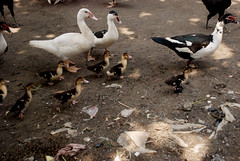 印尼政府已確定,在過去幾週內導致數十萬隻鴨子死亡的禽流感病毒,乃是有致命性的新病毒。
印尼政府已確定,在過去幾週內導致數十萬隻鴨子死亡的禽流感病毒,乃是有致命性的新病毒。
印尼家禽養殖協會向農業部通報,11月以來,爪哇(Java)數個省份中已有超過30萬隻鴨子死亡。
當地政府單位首席獸醫Syukur Iwantoro在給世界衛生組織(World Health Organization, WHO)的信中表示,新發現的禽流感病毒株(H5N1),是為一個「新的支系」,和先前在印尼發現的禽流感「非常不同」。
Iwantoro 表示,「我們發現了屬於2.3.2支系的高致病性禽流感病毒H5N1亞型。」他建議進行更深入的研究:印尼國內先前發現的病毒是否已產生變異,或該新支系乃是來自海外的新病毒株。新病毒株可能透過野鴨遷徙或家禽進口,而從印尼以外地區被引進。
現在,新病毒株有了它的第一個受害者。12月6日,西爪哇地區有個4歲男童在雅加達以西約25公里的堂格朗(Tangerang)醫院死亡,原因是感染禽流感。
12月12日,印尼衛生署(Ministry of Health)、疾病管制局(Directorate General of Disease Control)與環境衛生服務局(Environmental Health Service)發表一份聯合聲明表示,醫院與其他機構調查後發現,直接接觸家禽屍體與其附近地區的鴨子,都可能有高感染風險。
這是印尼自2012年7月30以來,第一宗人類感染禽流感案例。在此期間,各地並無其他感染報告。
H5N1亞型,是高致病性的禽流感病毒,於1997年禽流感在香港爆發期間,首次感染人類。
禽流感病毒於2003、2004年再次出現,迅速傳播,從亞洲蔓延到歐洲與非洲,已穩定存在於一些國家的家禽中,其已造成上百萬家禽、數百人感染,以及許多人的死亡。
2003年以來,全球感染禽流感的人數已升至609人,其中有359人死亡。
根據世界衛生組織的統計,印尼感染禽流感而死亡的人數比任何其他國家多得多,共計有359感染,159人死亡。
世界動物衛生組織(World Organisation for Animal Health, OIE)總幹事Bernard Vallat博士警告,動物疾病乃是全球安全的威脅。
12月10日,在生物武器公約(Biological Weapons Convention)會議上,Vallat博士發起行動,以對抗動物病原體增加,所可能產生的安全問題。
Vallat博士表示,今日,人類、動物和消費產品的移動,可能使感染性動物病原體迅速擴散。如果它們沒有在一開始就獲得控制的話,像SARS、禽流感、狂牛病與伊波拉病毒(Ebola)等,都是潛在災難的縮影。
他接著說,保護全世界免於動物病原體威脅的最好辦法,是確保所有國家獸醫單位之作業標準,皆符合世界動物衛生組織的國際標準。這是生物風險管理政策的基礎。
Vallat博士強調,「這是政府共同的責任,應使用一切可能的手段,採納現有預防及控制動物疾病的建議,以減少這些病原體產生的重大威脅。」
Indonesia has identified the bird flu virus that has killed hundreds of thousands of ducks over the past few weeks as a virulent type which is new to the country.
More than 300,000 ducks in several provinces on the island of Java have died since November, a poultry breeders’ association reported to the Indonesian Agriculture Ministry.
In a letter to local government offices and the World Health Organization, the ministry’s veterinary chief Syukur Iwantoro explains that the newly identified viral strain of avian A/(H5N1), called a “clade,” is “very different to the avian influenza found before” in Indonesia.
“We found a highly pathogenic avian influenza sub-type H5N1 with clade 2.3.2.,” Iwantoro wrote.
Iwantoro recommended further research into whether the virus previously found in the country has mutated, or whether the new strain originated overseas. The new strain may have been introduced from outside Indonesia by migratory wild ducks or by poultry imports from other countries.
Now, the new viral strain has claimed its first human victim. A four-year-old boy died from West Java died from bird flu on December 6 at the the Tangerang District Hospital about 25 km west of Jakarta.
Investigations conducted by the hospital and other agencies involved found a possible risk factor of direct contact with poultry carcasses, “including possible exposure to entog (ducks) in the neighborhood,” said a statement December 12 from three agencies – the Ministry of Health, the Directorate General of Disease Control, and the Environmental Health Service.
This is the first confirmed human case of avian A/(H5N1) influenza virus infection in Indonesia since July 30, 2012. There have been no other reports of human cases from elsewhere during this period.
The H5N1 virus subtype, a highly pathogenic avian influenza virus, first infected humans in 1997 during a poultry outbreak in Hong Kong.
Since its widespread re-emergence in 2003 and 2004, this avian virus has spread from Asia to Europe and Africa and has become entrenched in poultry in some countries, resulting in millions of poultry infections, several hundred human cases, and many human deaths.
The global total of human cases since 2003 now becomes 609 with 359 fatalities.
Indonesia has had a greater number of human fatalities from bird flu than any other country – with 159 deaths out of 359 worldwide – according to data from the World Health Organization.
Animal diseases are a threat to global security warned Director General of the World Organisation for Animal Health (OIE), Dr. Bernard Vallat.
On December 10 at the meeting of government parties to the Biological Weapons Convention, Dr. Vallat called for action against the rising threat that animal pathogens pose to the world’s security.
Today’s movements of people, animals and consumer goods enables the rapid global spread of infectious animal diseases: SARS, avian flu, mad cow disease, and Ebola are all examples highlighting the potentially disastrous consequences that animal pathogens can pose if they are not eliminated at their primary source,” he said.
“The best way to protect the entire world from rising bio-threats linked with animal pathogens is to ensure that all national veterinary services comply with OIE international standards on quality,” he said. “This must be a basis for bio risk management policies.”
“It is a shared responsibility of governments to use all means available and apply existing recommendations that we give to prevent and control animal diseases,” Dr. Vallat stressed. “This will reduce the significant risks that these pathogens present.”
※ 全文及圖片詳見:ENS


